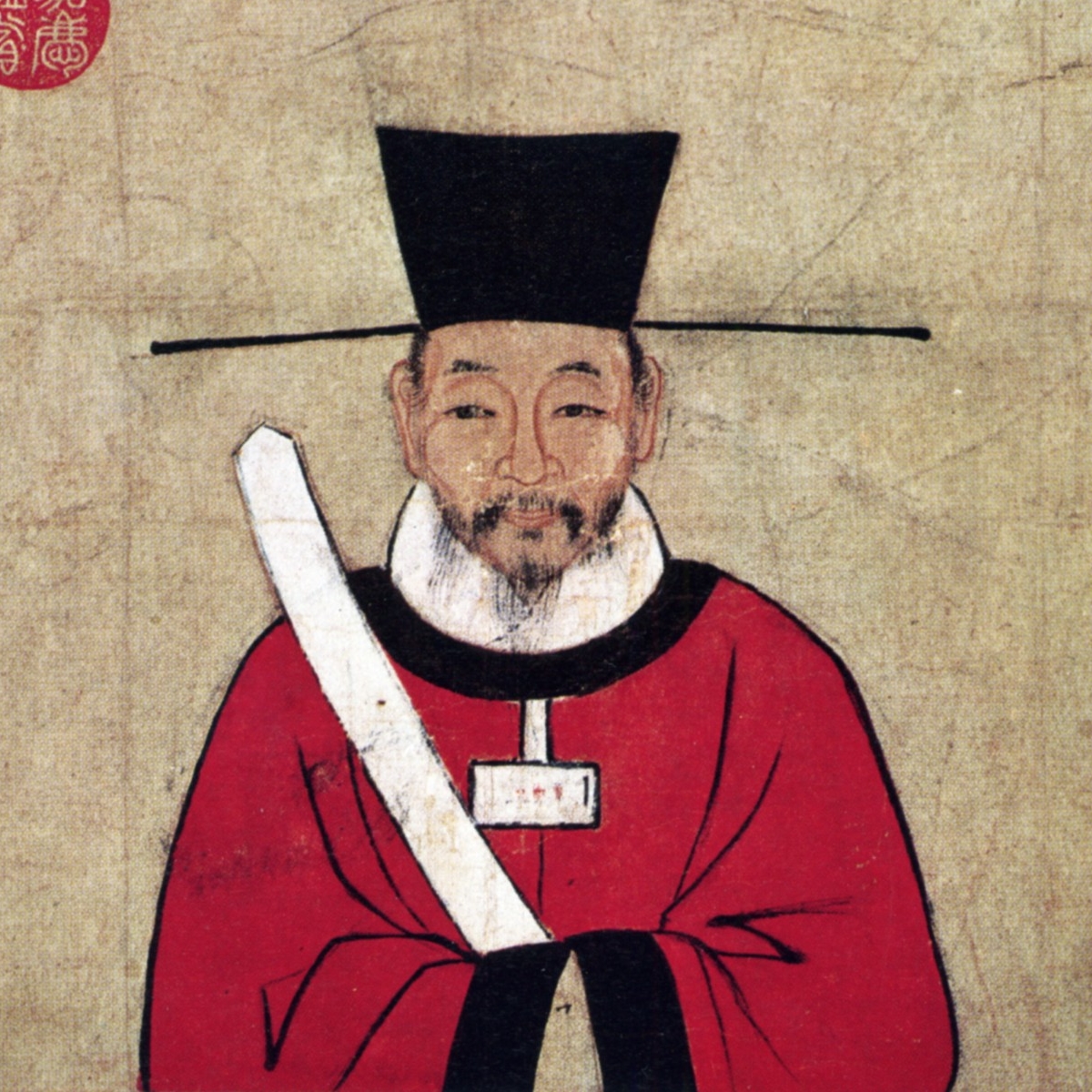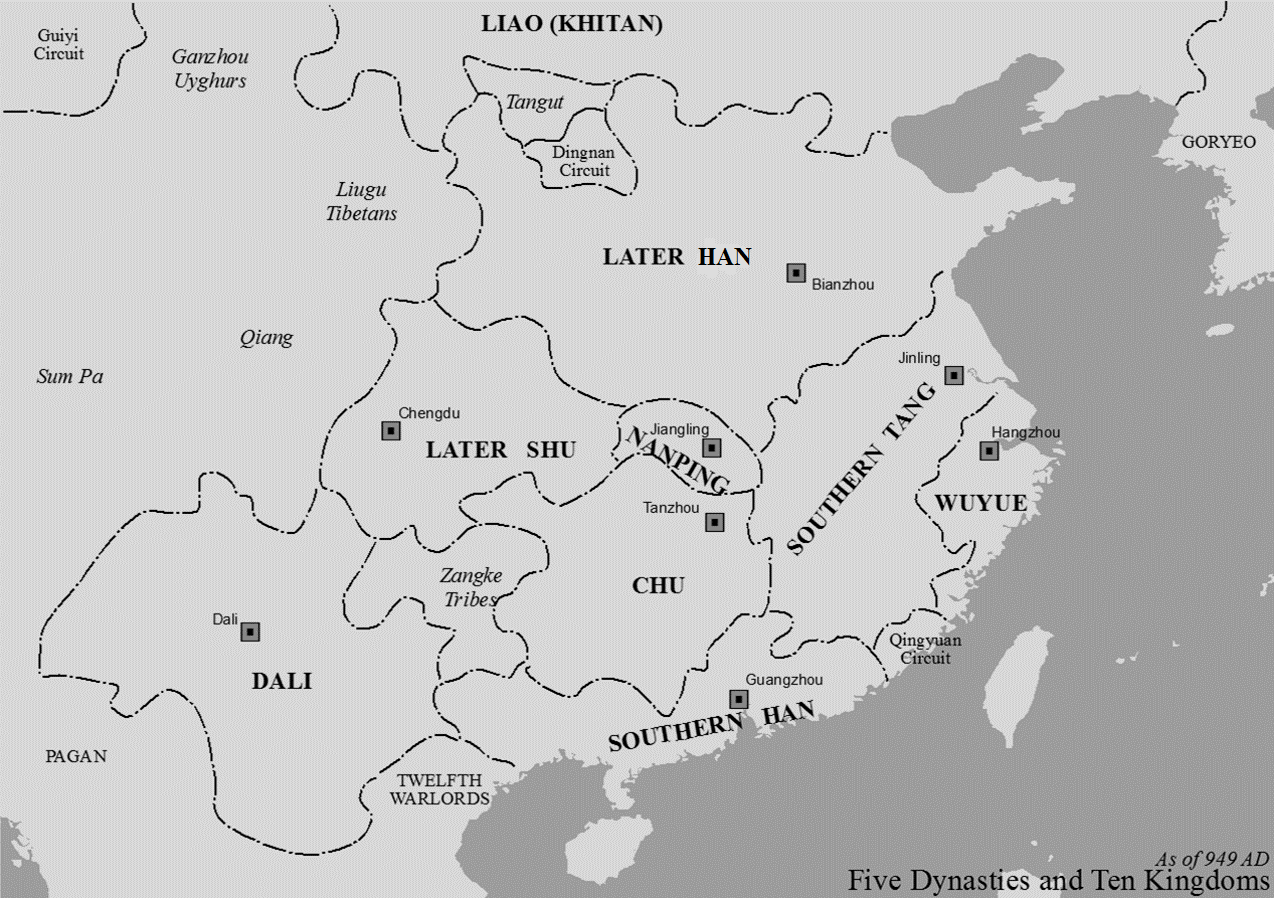|
An Congjin
An Congjin (; died 942) was a general of the Chinese Five Dynasties and Ten Kingdoms period states Later Tang and Later Jin. In 941, he rebelled against the rule of Later Jin's founding emperor Shi Jingtang, but was defeated, and he then committed suicide. Background and service under Li Cunxu It is not known when An Congjin was born. He was said to be of Sogdian stock, but his family had settled at the Tang dynasty's Zhenwu Circuit (振武, headquartered in Hohhot, Inner Mongolia). Both his grandfather and father (whose names were not recorded in history) were cavalry officers during Tang. At some point, An became an officer under Li Cunxu, Later Tang's founding emperor, although it is not known whether that was after Li Cunxu's founding of Later Tang or prior, perhaps during Li Cunxu's rule as the prince of Later Tang's predecessor state Jin. While serving under Li Cunxu, he reached the positions of commander of Li Cunxu's cavalry guards, as well as prefect of Gui P ... [...More Info...] [...Related Items...] OR: [Wikipedia] [Google] [Baidu] |
History Of China
The history of China spans several millennia across a wide geographical area. Each region now considered part of the Chinese world has experienced periods of unity, fracture, prosperity, and strife. Chinese civilization first emerged in the Yellow River valley, which along with the Yangtze basin constitutes the geographic core of the Chinese cultural sphere. China maintains a rich diversity of ethnic and linguistic people groups. The traditional lens for viewing Chinese history is the dynastic cycle: imperial dynasties rise and fall, and are ascribed certain achievements. This lens also tends to assume Chinese civilization can be traced as an unbroken thread many thousands of years into the past, making it one of the cradles of civilization. At various times, states representative of a dominant Chinese culture have directly controlled areas stretching as far west as the Tian Shan, the Tarim Basin, and the Himalayas, as far north as the Sayan Mountains, and as far south ... [...More Info...] [...Related Items...] OR: [Wikipedia] [Google] [Baidu] |
Jiedushi
The ''jiedushi'' (, Old Turkic: Tarduş) or jiedu, was a regional military governor in China; the title was established in the Tang dynasty and abolished in the Yuan dynasty. The post of ''jiedushi'' has been translated as "military commissioner", " legate", or "regional commander". Originally introduced in 711 to counter external threats, the ''jiedushi'' were posts authorized with the supervision of a defense command often encompassing several prefectures, the ability to maintain their own armies, collect taxes and promote and appoint subordinates. Powerful ''jiedushi'' eventually became '' fanzhen'' rulers (''de facto'' warlords) and overrode the power of the central government of Tang. An early example of this was An Lushan, who was appointed ''jiedushi'' of three regions, which he used to start the An Lushan Rebellion that abruptly ended the golden age of the Tang dynasty. Even after the difficult suppression of that rebellion, some ''jiedushi'' such as the Three Fanz ... [...More Info...] [...Related Items...] OR: [Wikipedia] [Google] [Baidu] |
Li Conghou
Li Conghou () (914–934), posthumous name Emperor Min of Later Tang (), childhood name Pusanu (菩薩奴, "slave of a Bodhisattva"), was an emperor of the Later Tang dynasty of China, ruling between 933 and 934. He was overthrown by his adopted brother Li Congke. Background Li Conghou was born in 914, when his father Li Siyuan was a general of Jin (predecessor state to Later Tang), under his adoptive brother (Li Conghou's adoptive uncle) Li Cunxu the Prince of Jin. His mother was Lady Xia, who was either a concubine of Li Siyuan's or a co-wife with Lady Cao, and who was also the mother of his older brother Li Congrong.''Old History of the Five Dynasties'', vol. 49. He was either Li Siyuan's third son (per the ''Old History of the Five Dynasties'') or his fifth son (per the ''New History of the Five Dynasties'').''New History of the Five Dynasties'', vol. 7. He was born at Li Siyuan's mansion in then-Jin capital Taiyuan. It was said that even in his childhood, he li ... [...More Info...] [...Related Items...] OR: [Wikipedia] [Google] [Baidu] |
Zizhi Tongjian
The ''Zizhi Tongjian'' (1084) is a chronicle published during the Northern Song dynasty (960–1127) that provides a record of Chinese history from 403 BC to 959 AD, covering 16 dynasties and spanning almost 1400 years. The main text is arranged into 294 scrolls (), each equivalent to a chapter—totaling around 3 million Chinese characters. In 1065, Emperor Yingzong of Song commissioned his official, Sima Guang (1019–1086), to lead a project to compile a Universal history (genre), universal history of China, and granted him funding and the authority to appoint his own staff. His team took 19 years to complete the work and in 1084 it was presented to Emperor Yingzong's successor Emperor Shenzong of Song. It was well-received and has proved to be immensely influential among both scholars and the general public. Endymion Wilkinson regards it as reference quality: "It had an enormous influence on later Chinese historical writing, either directly or through its many a ... [...More Info...] [...Related Items...] OR: [Wikipedia] [Google] [Baidu] |
Xianyang
Xianyang ( zh, s=咸阳 , p=Xiányáng) is a prefecture-level city in central Shaanxi province, situated on the Wei River a few kilometers upstream (west) from the provincial capital of Xi'an. Once the capital of the Qin dynasty, it is now integrated into the Xi'an metropolitan area, one of the main urban agglomerations in northwestern China, with more than 7.17 million inhabitants. Its built-up area, consisting of 2 urban districts (Qindu and Weicheng), had 945,420 inhabitants at the 2010 census. It has a total area of . Xianyang is the seat of the Xi'an Xianyang International Airport, the main airport serving Xi'an and the largest airport in Northwest China, and one of the 40 busiest airports in the world. Xianyang is one of the top 500 cities in the world by scientific research outputs, as tracked by the Nature Index. It is home to the main campus of Northwest A&F University (NWAFU), one of the world's top universities in agriculture science related fields, and a m ... [...More Info...] [...Related Items...] OR: [Wikipedia] [Google] [Baidu] |
Li Yichao
Li Yichao () (died 935) was an ethnically-Dangxiang warlord of the History of China, Chinese Five Dynasties and Ten Kingdoms Period state Later Tang, ruling Dingnan Jiedushi, Dingnan Circuit (定難, headquartered in modern Yulin, Shaanxi) from 933 to his death in 935, as its military governor (''Jiedushi'') in ''de facto'' independence. Background It is not known when Li Yichao was born. He was the second son of Li Renfu. During Li Renfu's rule of Dingnan Circuit, he served as an officer at Dingnan's capital Xia Prefecture (夏州, in modern Yulin, Shaanxi, Yulin, Shaanxi).''Old History of the Five Dynasties'', :zh:s:舊五代史/卷132, vol. 132. Campaign against Later Tang forces When Li Renfu died in 933, the officers of the circuit supported Li Yichao to succeed him, and he claimed the title of acting military governor, and thereafter sought to be officially commissioned as military governor from Later Tang.''Zizhi Tongjian'', :zh:s:資治通鑑/卷278, vol. 278. However, ... [...More Info...] [...Related Items...] OR: [Wikipedia] [Google] [Baidu] |
Yulin, Shaanxi
Yulin ( zh, s=榆林 , p=Yúlín , ‘’’local pronunciation:[ˈy³⁵ˌljʌŋ]’’’) is a prefecture-level city in the Shaanbei region of Shaanxi province, China, bordering Inner Mongolia to the north, Shanxi to the east, and Ningxia to the west. It has an administrative area of and as of the 2020 Chinese census had a population of 3,634,750. History Yulin played host to the 11th CHIME (European Foundation for Chinese Music Research) conference in August 2006. From 26–29 August 2017, the 1st IGU-AGLE Commission's conference on 'Global Rural Development and Land Capacity Building.' was held in Yulin University. Geography Yulin is the northernmost prefecture-level city of Shaanxi, and borders Ordos City (Inner Mongolia) to the north, Xinzhou and Lüliang (Shanxi) to the east, Yan'an to the south, and Wuzhong, Ningxia, Wuzhong (Ningxia) to the west. To the north and northwest of the city lies the Ordos Desert, though the countryside is very green due to the many small shru ... [...More Info...] [...Related Items...] OR: [Wikipedia] [Google] [Baidu] |
Dingnan Jiedushi
Dingnan Jiedushi (), also known as Xiasui Jiedushi (), was a ''jiedushi'' created in 787 by the Tang dynasty that lasted until the early Northern Song dynasty, when its ruler Li Yuanhao proclaimed himself emperor and established the Western Xia dynasty. Its seat was in modern Yulin, Shaanxi. Its rulers were of Tangut ethnicity starting from Li Sigong (Tuoba Sigong), and they effectively ruled the circuit in ''de facto'' independence despite its nominal submission to the central Chinese dynasties. Attempts by the Later Tang and Song dynasty to dislodge the family from its rule of Dingnan Jiedushi were unsuccessful, and the region eventually became the independent dynasty of Western Xia. Pre-''de facto'' independent Dingnan Jiedushi * Han Tan () (787-798) * Han Quanyi () (798–805) * Yang Huilin () (805–806) * Li Yuan () (806–811) * Zhang Xu () (811–813) * Tian Jin () (813–819) * Li Ting () (819–820) * Li You () (820–824) * Fu Liangbi () (824–828) * Li Huan () ( ... [...More Info...] [...Related Items...] OR: [Wikipedia] [Google] [Baidu] |
Li Renfu
Li Renfu (李仁福) (died March 10, 933''Zizhi Tongjian'', vol. 278.Academia Sinicabr>Chinese-Western Calendar Converter), possibly né Tuoba Renfu (拓拔仁福), formally the Prince of Guo (虢王), was an ethnic Dangxiang (Tangut) warlord during the Five Dynasties and Ten Kingdoms period, ruling Dingnan Circuit (定難, headquartered in modern Yulin, Shaanxi) from 909 or 910 to his death in 933, as its military governor (''jiedushi'') in ''de facto'' independence. Background Li Renfu was said to be from the same Tuoba clan as the late-Tang dynasty warlord Li Sigong (né Tuoba Sigong), the first Dangxiang military governor of Dingnan,''Old History of the Five Dynasties'', vol. 132. and therefore was ethnically Dangxiang.See '' New Book of Tang'', vol. 221, part 1. His relationship to Li Sigong was not clear from the traditional Chinese sources—the ''Old History of the Five Dynasties'' indicated that he also took the Tang dynasty imperial clan surname of Li when Li Sigo ... [...More Info...] [...Related Items...] OR: [Wikipedia] [Google] [Baidu] |
Shaanxi
Shaanxi is a Provinces of China, province in north Northwestern China. It borders the province-level divisions of Inner Mongolia to the north; Shanxi and Henan to the east; Hubei, Chongqing, and Sichuan to the south; and Gansu and Ningxia to the west. Shaanxi covers an area of over with about 37 million people, the 16th-largest in China. Xi'anwhich includes the sites of the former capitals Fenghao and Chang'anis the provincial capital and largest city in Northwest China and also one of the oldest cities in China and the oldest of the Historical capitals of China, Four Ancient Capitals, being the capital for the Western Zhou, Western Han, Sima Jin, Jin, Sui dynasty, Sui and Tang dynasty, Tang List of Chinese dynasties, dynasties. Xianyang, which served as the capital of the Qin dynasty (221–206 BC), is just north across the Wei River. The other Prefectures of China, prefecture-level prefecture-level city, cities into which the province is divided are Ankang, Baoji, Hanzho ... [...More Info...] [...Related Items...] OR: [Wikipedia] [Google] [Baidu] |



